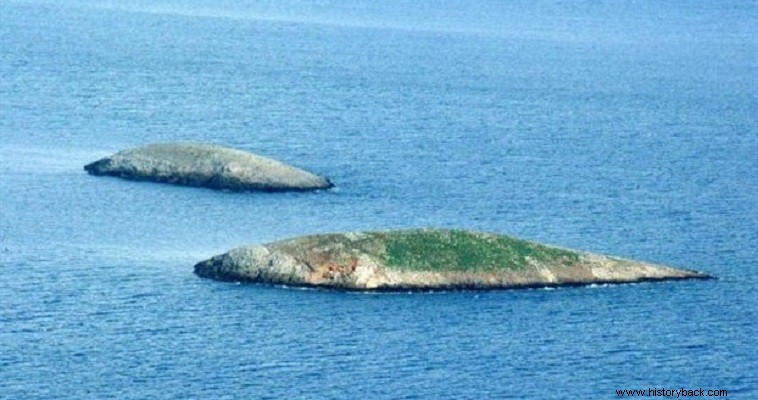
It was January 31, 1996 when the biggest Turkish provocation against Greece took place which claimed the lives of three Navy officers and became known as the Imia crisis. The lieutenants Christodoulos Karathanasis and Panagiotis Vlahakos as well as the chief pilot Hector Gialopsos gave their lives in an event that was classified as an accident due to bad weather conditions. January 31st was the day of the climax of a crisis that had actually started since Christmas 1995.
Christmas 1995 was the beginning
The Turkish cargo ship Figen Akat ran aground on December 25 in shallow waters near Mikri Imia and issued a distress signal. The nearest port authority is that of Kalymnos, which has a tugboat to detach the ship, however, the master refuses, stating that he is in Turkish territory and the Turkish authorities must offer help.
On December 26, the port authority informs the Ministry of Foreign Affairs, which notifies the secretary of the Directorate of Greek Affairs of the Turkish Ministry of Foreign Affairs, Cinar Egin, that the Turkish ship was in danger without the tug's intervention.
On December 27, the Turkish Ministry of Foreign Affairs informs the Greek embassy that there is a general issue with the Imia, regardless of the rescue of the ship. On December 28, two Greek tugboats detached the Turkish truck and took it to the Turkish port of Külük.
On December 29, the Turkish Ministry of Foreign Affairs sends a notice to the corresponding Greek, where it is stated that the Imia rock islands are registered in the Mugla land register of Bodrum (Halicarnassus) prefecture and belong to Turkey. The event caused Turkey to raise the issue of ownership of the islands. /P>
The crisis in Imia
These claims of Turkey on the two rocky islets of Imia lead the then mayor of Kalymnos, Dimitris Diakomichalis, on January 25, 1996, to raise the Greek flag on one of the two rocky islets, Mikri Imia. He was accompanied by the police director of the island, Giorgos Riolas, and two residents. On January 26, the Greek flag was also raised on the other islet. The images with the Greek flag in Imia are broadcast by Turkish television networks, causing disturbance in Turkish public opinion.
On January 27, two "journalists" working for the Hurriyet newspaper in the Izmir offices moved by helicopter to Mikri Imia and took down the Greek flag and raised a Turkish one in its place. This operation is videotaped and shown on the newspaper's television network.
This move and the showing of the video fueled the fire. On the morning of Sunday, January 28, 1996, the patrol boat "Antonio" of the Navy lowers the Turkish flag and raises the Greek flag again, violating the political mandate it had, which was only to fly the Turkish flag.
In the evening of the same day, frogmen disembark from the patrol car "Pyrpolitis" in Mikri Imia to guard the Greek flag and return before sunrise. At noon on Monday, January 29, it is decided to continue guarding the flag and the frogmen return to the rock island.
On the afternoon of Monday, January 29, Prime Minister Kostas Simitis, who had just taken office due to Andreas Papandreou's illness, sent a message to Turkey in his programmatic statements to Parliament that Greece will react dynamically and immediately to any challenge. On Tuesday, January 30, the Prime Minister of Turkey, Tansu Çiler, speaks in Parliament and announces that the Greek flag and the Greek army will be removed from Imia.
On January 31, at 01:40 Turkish special forces land on the rocky island of Megali Imia. At 05:30 a Navy helicopter "takes off" from the "Navarino" frigate to check the information about the presence of Turks on the rocky island. On his return to the frigate, all three crew members, the lieutenant Christodoulos Karathanasis, the lieutenant Panagiotis Vlahakos and the chief pilot Hektor Gialopsos, are killed. The Navy officially reports that the helicopter went down due to bad weather conditions that caused the pilot to become disoriented.
Extinction of the crisis and "gray zones"
At the height of the crisis, the US exerted pressure to end the episode, with then-President Bill Clinton being informed by Tansu Çiler that Greece and Turkey were headed for war "because two Turkish journalists and some Greek boatmen ran aground on a rock inhabited by a goat ». Diplomat Richard Holbrooke, briefed by the American president, contacted the two prime ministers by phone who pledged to withdraw their forces and lower the flags.
The warships and commandos of the two countries left the islets on the morning of January 31, 1996 under the surveillance of aircraft of the US 6th Mediterranean Fleet.
“I want to thank the US government”
On February 1, 1996, Prime Minister Costas Simitis said from the floor of Parliament:"I want to thank the government of the United States for their initiative and help." This move by the prime minister at the time caused intense reactions in the room, indicative of the tense atmosphere in the domestic political scene.
The climate worsens when, a few days later, classified State Department documents are made public, according to which Theodoros Pagalos, talking to his American counterpart, Warren Christopher, replied that the Greek state will withdraw the Greek flag and that it will not be replaced, as "in the region strong winds are blowing".
Admiral Christos Lymberis had made a similar complaint, who claimed that in the morning hours of January 31, he heard the exact same phrase from Mr. Pagalos, in the office of Costas Simitis. It is noted that, at the time of the Imian crisis, the Minister of Foreign Affairs was Theodoros Pangalos, the Minister of National Defense was Gerasimos Arsenis and the head of the Greek Navy was Admiral Christos Lymberis. In Turkey, Prime Minister was Tansu Ciller and Minister of Foreign Affairs Onur Oymen.
SOURCE:SPUTNIK
